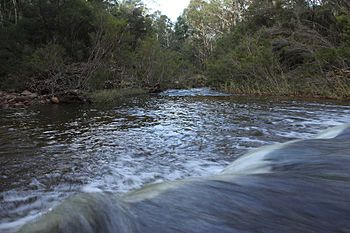Wolgan River facts for kids
Quick facts for kids Wolgan |
|
|---|---|

Wolgan River, near Newnes
|
|
| Country | Australia |
| State | New South Wales |
| IBRA | Sydney Basin |
| District | Central Tablelands |
| Local government area | Lithgow |
| Physical characteristics | |
| Main source | Great Dividing Range northeast of Wallerawang 1,070 m (3,510 ft) 33°22′55″S 150°09′37″E / 33.381835°S 150.160414°E |
| River mouth | confluence with the Capertee River below Mount Morgan, east of Glen Davis 178 m (584 ft) 33°12′20″S 150°27′54″E / 33.205542°S 150.465008°E |
| Length | 40 km (25 mi) |
| Basin features | |
| River system | Hawkesbury-Nepean catchment |
| National park | Wollemi National Park |
The Wolgan River is a cool watercourse in the Central Tablelands area of New South Wales, Australia. It's part of the bigger Hawkesbury-Nepean river system.
Contents
Where Does the Wolgan River Flow?
The Wolgan River starts high up on the eastern side of the Great Dividing Range. This is a huge mountain range in Australia. It begins near a town called Lithgow.
River's Journey
The river is formed when two smaller streams meet: Carne Creek and the Wolgan River (Western Branch). From there, it flows in many directions, twisting and turning. It goes north, then northeast, then east, and finally northeast again.
It travels about 63 kilometres (39 mi) in total. Along its journey, the river drops a lot in height, about 897 metres (2,943 ft) from its start to its end.
Meeting Another River
The Wolgan River eventually joins another river called the Capertee River. This meeting point is located east of a place called Glen Davis, below Mount Morgan.
Wolgan River and Nature
Most of the Wolgan River flows through a special place called Wollemi National Park. This park is known for its amazing nature and wild areas.
Wolgan Valley
The river also runs through the beautiful Wolgan Valley. This valley is home to lots of plants and animals. You can find the old, empty town of Newnes along the river too.
World Heritage Site
The area where the Wolgan River flows is part of the Greater Blue Mountains Area. This whole region is so important and unique that it's listed as a UNESCO World Heritage Site. This means it's recognized globally for its natural beauty and importance.

